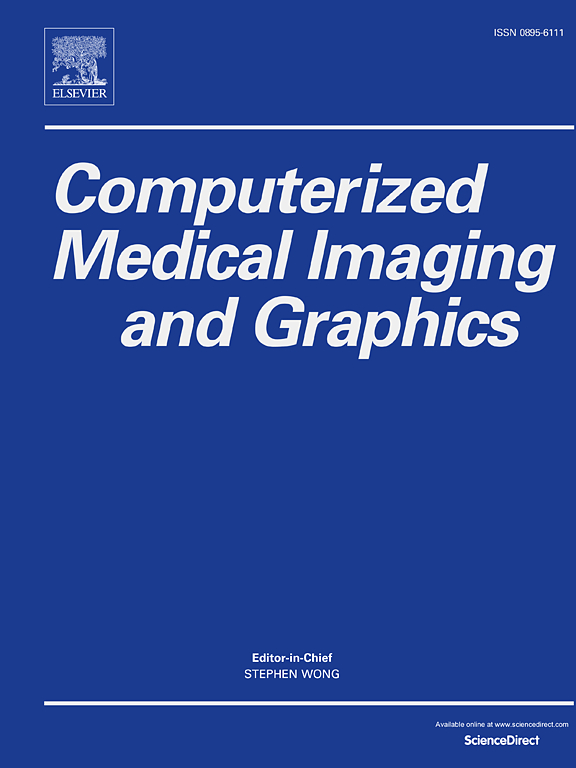Hierarchical attention fusion of EUS-doppler features for GISTs risk assessment
IF 4.9
2区 医学
Q1 ENGINEERING, BIOMEDICAL
Computerized Medical Imaging and Graphics
Pub Date : 2025-07-05
DOI:10.1016/j.compmedimag.2025.102584
引用次数: 0
Abstract
Assessing the preoperative malignancy risk of gastrointestinal stromal tumors (GISTs) is crucial for determining the appropriate treatment plan and prognosis. The current automated diagnosis of GISTs based on endoscopic ultrasound (EUS) pose challenge in stable GISTs classification due to the similarity in structure among different risk levels, thus incorporating blood flow density information from Doppler images is essential to assist in the diagnosis. Meanwhile, the variability of tumor size leads to limitations in feature extraction, as a single receptive field is unable to capture both global and local features, which in turn affects classification accuracy. In this paper, we propose a Hierarchical Attention-based Multimodal Feature Fusion Network (HAMNet) for stable GISTs diagnosis by fusing both structural and blood flow information. First, both EUS and Doppler image features are extracted through specific branches to preserve intra-modal information and the masks are added for location supplementary. Second, they are integrated through an iterative multimodal attention integrator (IMAI) which is designed to utilize supervised blood flow information from Doppler images and selectively enhance structural information from EUS images. This is achieved by emphasizing cross-modal complementary features through an attention mechanism and facilitating further refinement of multimodal information through an iteration strategy. Third, we devise a Hierarchical Multi-Scale Tumor Classification (HMTC) module, which enables the model to accommodate the varying sizes of GISTs by capturing features across different receptive fields. Afterwards, we construct a first GISTs dataset called pEUS-Doppler-GISTs comprising 179 cases with 555 paired endoscopic ultrasound (EUS) and Doppler images and conduct experiments to validate the performance of our HAMNet in preoperative malignancy risk assessment. HAMNet has been demonstrated to outperform other state-of-the-art (SOTA) algorithms, achieving an ACC and AUC of 0.875 and 0.856, respectively. It is noteworthy that the model sensitivity is enhanced by a maximum of 0.196 in comparison to other multimodal methods, indicating its effectiveness in identifying high risk tumors and potential application in GISTs CAD systems.
eus -多普勒特征的分层注意力融合用于gist风险评估
术前评估胃肠道间质瘤(gist)的恶性风险对于确定合适的治疗方案和预后至关重要。目前基于内镜超声(EUS)的胃肠道间质瘤自动诊断由于不同危险级别间的结构相似,对稳定的胃肠道间质瘤分类提出了挑战,因此多普勒图像的血流密度信息是辅助诊断的必要条件。同时,肿瘤大小的可变性导致特征提取的局限性,因为单一的感受野无法同时捕获全局和局部特征,从而影响分类精度。在本文中,我们提出了一种基于分层注意力的多模态特征融合网络(HAMNet),通过融合结构和血流信息来稳定诊断胃肠道间质瘤。首先,通过特定分支提取EUS和多普勒图像特征,保留模内信息,并添加掩模进行位置补充。其次,它们通过迭代多模态注意力积分器(IMAI)进行集成,该积分器旨在利用多普勒图像中的监督血流信息,并选择性地增强EUS图像中的结构信息。这是通过注意机制强调跨模态互补特征,并通过迭代策略促进多模态信息的进一步细化来实现的。第三,我们设计了一个分层多尺度肿瘤分类(HMTC)模块,该模块使模型能够通过捕获不同感受野的特征来适应不同大小的gist。随后,我们构建了第一个gist数据集,称为peus -Doppler- gist,包含179例555对内镜超声(EUS)和多普勒图像,并通过实验验证了我们的HAMNet在术前恶性肿瘤风险评估中的性能。HAMNet已被证明优于其他最先进的(SOTA)算法,其ACC和AUC分别为0.875和0.856。值得注意的是,与其他多模态方法相比,该模型的灵敏度提高了0.196,表明其在识别高风险肿瘤方面的有效性和在gist CAD系统中的潜在应用。
本文章由计算机程序翻译,如有差异,请以英文原文为准。
求助全文
约1分钟内获得全文
求助全文
来源期刊
CiteScore
10.70
自引率
3.50%
发文量
71
审稿时长
26 days
期刊介绍:
The purpose of the journal Computerized Medical Imaging and Graphics is to act as a source for the exchange of research results concerning algorithmic advances, development, and application of digital imaging in disease detection, diagnosis, intervention, prevention, precision medicine, and population health. Included in the journal will be articles on novel computerized imaging or visualization techniques, including artificial intelligence and machine learning, augmented reality for surgical planning and guidance, big biomedical data visualization, computer-aided diagnosis, computerized-robotic surgery, image-guided therapy, imaging scanning and reconstruction, mobile and tele-imaging, radiomics, and imaging integration and modeling with other information relevant to digital health. The types of biomedical imaging include: magnetic resonance, computed tomography, ultrasound, nuclear medicine, X-ray, microwave, optical and multi-photon microscopy, video and sensory imaging, and the convergence of biomedical images with other non-imaging datasets.

 求助内容:
求助内容: 应助结果提醒方式:
应助结果提醒方式:


